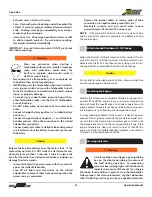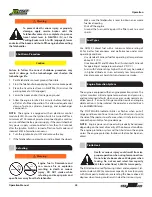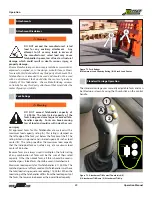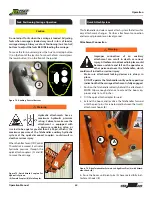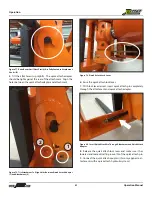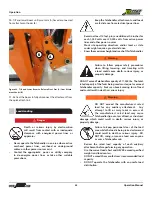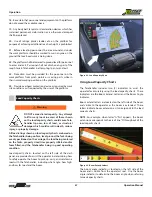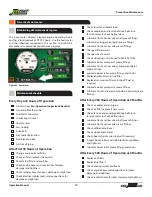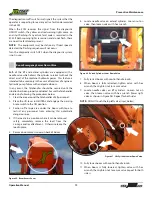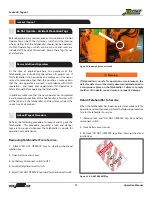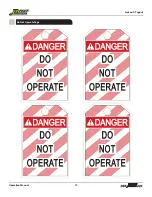
Operation Manual
67
Operation
Load Capacity Charts
Warning
DO NOT exceed rated capacity. Any attempt
to lift or carry loads in excess of those shown
on the load capacity charts could cause Tele-
handler tip over, loss of load, or structural
damage which could result in death, serious
injury, or property damage.
All load ratings shown on load capacity charts are based on
the Telehandler being on firm, level ground, the forks being
evenly positioned on the carriage, the load being centered
on the forks, properly sized tires properly inflated and/or
foam filled, and the Telehandler being in good operating
condition.
Load capacity charts, located on the left side of the dash
panel, are provided to assist the operator in determining how
to safely operate the boom to pick up, carry, and set down a
load with the Telehandler, including what angle, how high,
and how far to extend the boom.
Figure 88. Load Capacity Chart
18.
Be certain that personnel and equipment on the platform
do not exceed the available space.
19.
Any body belt, lanyard, or deceleration devices which has
sustained permanent deformation or is otherwise damaged
shall be replaced.
20.
Use of railings, planks, ladder, etc. on the platform for
purpose of achieving additional reach or height is prohibited.
21.
Before elevating personnel, the area around and under
the work platform should be marked to warn anyone on the
ground that overhead work is being done.
22.
The platform shall be lowered to ground level for personnel
to enter and exit. Personnel shall not climb on any part of the
rough terrain Telehandler in attempting to enter and exit.
23.
Protection must be provided for the personnel on the
work platform from pinch points or moving parts while in
their normal working position on the platform.
24.
Provide overhead protection device as required by work
site conditions or if requested by the user of the platform.
Using Load Capacity Charts
The Telehandler includes two (2) indicators to assist the
operator for accurately using the load capacity charts. These
indicators are the Boom Extend Letters and the Boom Angle
Indicator.
Boom extend letters are located on the left side of the boom
and visible to the operator as the boom is extended. These
letters indicate boom extension as it corresponds to the load
capacity charts.
NOTE:
For example, when letter “A” first appears, the boom
extension corresponds to the arc of line “A” throughout all the
load capacity charts.
Figure 89. Boom Extend Letters
The boom angle indicator is located on the left side of the
boom and is visible from the operator’s seat. Use the boom
angle indicator to determine the boom angle when referring
to load capacity charts.

